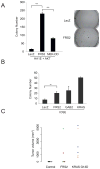The Tyrosine Kinase Adaptor Protein FRS2 Is Oncogenic and Amplified in High-Grade Serous Ovarian Cancer
- PMID: 25368431
- PMCID: PMC4369154
- DOI: 10.1158/1541-7786.MCR-14-0407
The Tyrosine Kinase Adaptor Protein FRS2 Is Oncogenic and Amplified in High-Grade Serous Ovarian Cancer
Abstract
High-grade serous ovarian cancers (HGSOC) are characterized by widespread recurrent regions of copy-number gain and loss. Here, we interrogated 50 genes that are recurrently amplified in HGSOC and essential for cancer proliferation and survival in ovarian cancer cell lines. FRS2 is one of the 50 genes located on chromosomal region 12q15 that is focally amplified in 12.5% of HGSOC. We found that FRS2-amplified cancer cell lines are dependent on FRS2 expression, and that FRS2 overexpression in immortalized human cell lines conferred the ability to grow in an anchorage-independent manner and as tumors in immunodeficient mice. FRS2, an adaptor protein in the FGFR pathway, induces downstream activation of the Ras-MAPK pathway. These observations identify FRS2 as an oncogene in a subset of HGSOC that harbor FRS2 amplifications.
Implications: These studies identify FRS2 as an amplified oncogene in a subset of HGSOC. FRS2 expression is essential to ovarian cancer cells that harbor 12q15 amplification.
©2014 American Association for Cancer Research.
Conflict of interest statement
Disclosure of Potential Conflicts of Interest: WCH is a consultant to Novartis and RRS is an employee of Astellas Pharma US.
Figures




References
-
- Bowtell DD. The genesis and evolution of high-grade serous ovarian cancer. Nat Rev Cancer. 2010;10:803–8. - PubMed
Publication types
MeSH terms
Substances
Grants and funding
LinkOut - more resources
Full Text Sources
Other Literature Sources
Medical

